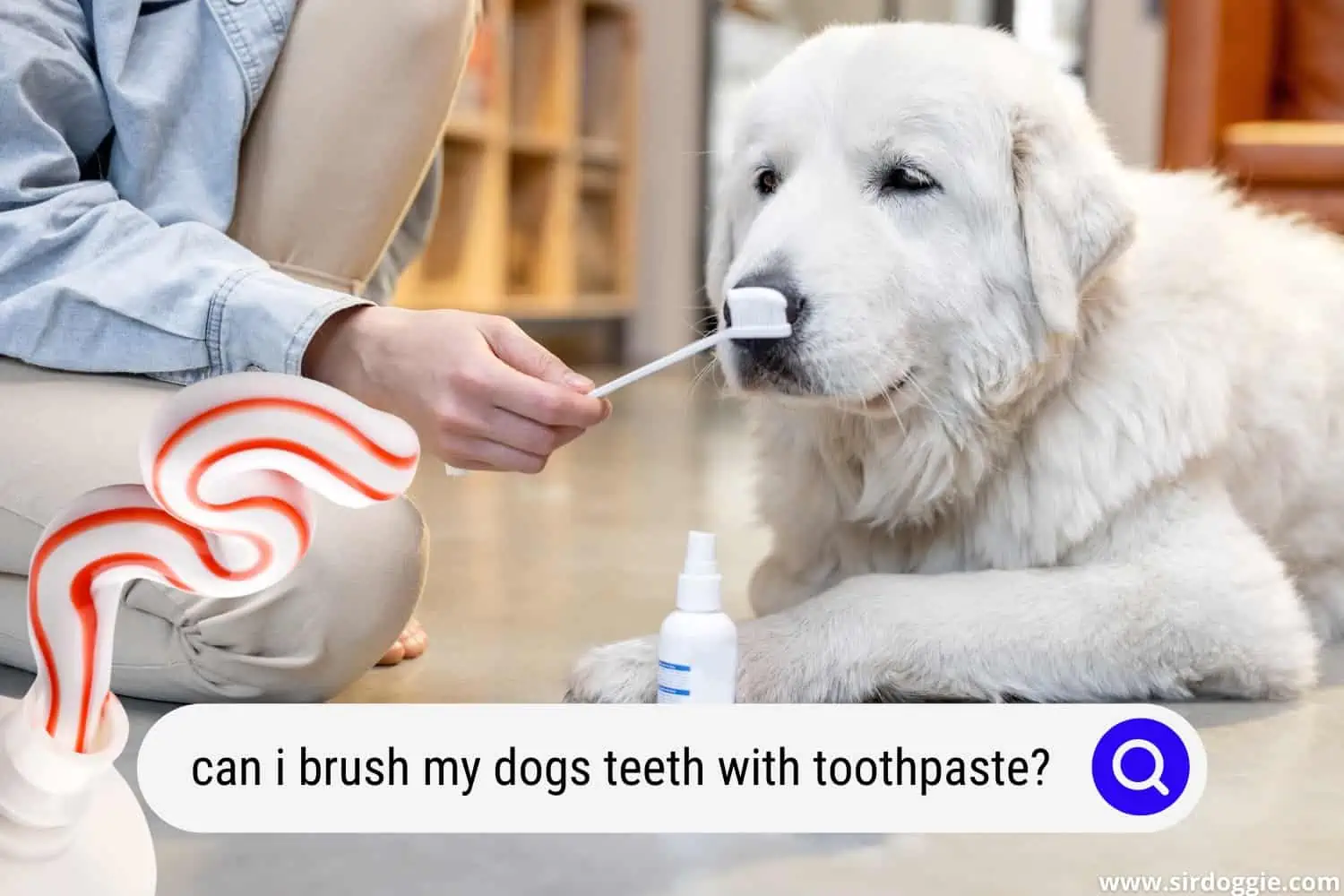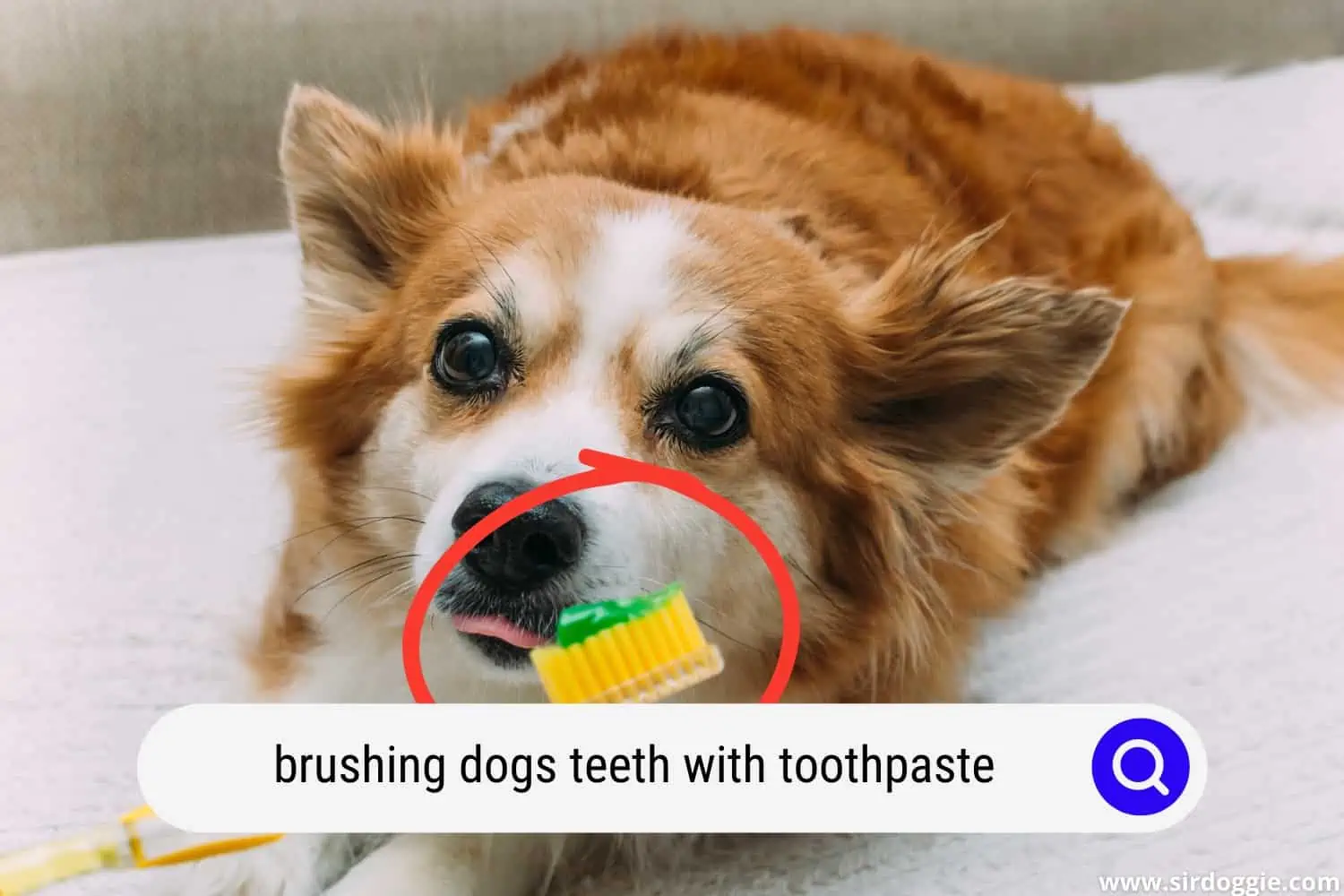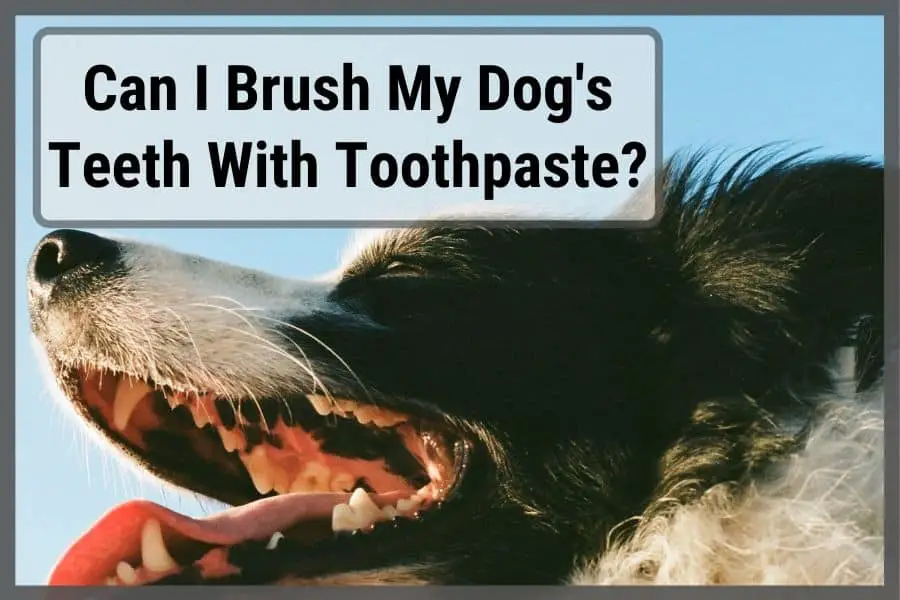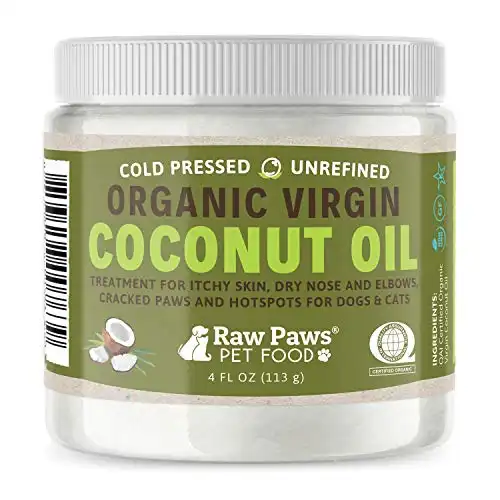Can I Brush My Dogs Teeth With Toothpaste?
So, can you brush your dog’s teeth with toothpaste? No, you can’t brush your dog’s teeth with human toothpaste as it can be harmful to your dog. There is dog-specific toothpaste available and this will be a better option for your dog. There are several substances you can use to brush your dog’s teeth, but toothpaste made for humans isn’t one of them.

Many people believe that a dog’s teeth magically clean themselves. As such, they limit the care they give to their dog to essentials like feeding and grooming.
Unfortunately, this means many pet parents often neglect one of the most fundamental aspects of animal care – dental hygiene. As humans, we take our own dental hygiene very seriously.
Brushing your teeth is one of the first skills you learn as a child. But we often fail to extend that necessity to our canine companions.
We understand many pet parents may be in a pinch and think using toothpaste made for humans won’t hurt every once in a while. But if that’s the situation you find yourself in, ditch the human toothpaste, brushing with nothing still helps and will limit the risk.
To learn more about how to brush your dog’s teeth properly and what you can use to brush with, then read on.
Related Reading: How to Brush Small Dog’s Teeth
Are you supposed to brush a dog’s teeth?
Yes, you are supposed to brush a dog’s teeth. It is just as important to brush your dog’s teeth as your own.
Dog teeth are just as fragile and susceptible to issues as human teeth.
Remember what it’s like to have a cavity or toothache? Well, your dog is just as likely to get a cavity or contract gum disease if you don’t clean their teeth regularly.
Periodontal disease is a very common infection of the gums and teeth caused by the build-up of plaque and gingivitis.
Without regular cleaning, there’s a good chance your dog will contract this illness. Brushing your dog’s teeth is, therefore, critical for sound oral hygiene.
Pet parents commonly avoid looking after their dog’s teeth for several reasons.
- Some find the prospect of going near their dog’s mouth a little scary.
- Others do not want to put their dog through what they perceive to be an unpleasant experience.
As a responsible pet parent, you must not let these excuses put your dog at risk. Dogs can’t go to the store and pick up their own oral hygiene supplies. Sure, dogs can’t brush their teeth in the wild, but they would be eating a totally different diet (raw meat and bones) and would be gnawing on those bones a lot.
Plain and simple, brushing your dog’s teeth will only add to their well-being, not take away from it.
You should brush your dog’s teeth at least once per day, if possible. Of course, some dogs are very resistant to having their teeth cleaned. If this is a problem for you, please talk to your vet about ways you can calm your dog down when you brush their teeth.
What can you brush a dog’s teeth with?
One of the most common questions a new dog owner will ask when thinking about brushing their teeth is what to brush with.
Toothpaste, coconut oil, and baking soda are three of the most common choices.
Whatever you do, never use human toothpaste to clean a dog’s teeth. Human toothpaste often includes chemicals that can prove toxic to dogs.
To avoid poisoning your dog, use dog-specific toothpaste, like this one, that includes all of the safe scrubbings and cleaning agents found in human toothpaste.
Aside from toxicity, one of the main differences is that it will typically be flavoured with tastes that dogs enjoy. For example, beef, poultry, and malt are all typical doggy toothpaste flavours.
Should I use a toothbrush to brush my dog’s teeth?
There are two common ways of cleaning a dog’s teeth: toothbrushes and finger brushes.
The brushing method you use depends on the temperament of your dog and your willingness to put your fingers inside the dog’s mouth.
A doggie toothbrush is very similar to a human toothbrush – it’s basically a plastic stick with some bristles at the end.
The bristles are usually softer than the hairs on standard human toothbrushes. Soft bristle human toothbrushes can, therefore, be used if you don’t have a dog-specific brush on hand.
Finger brushes are small brushes that slip over the end of your finger (they look like this). The main advantage is that you can feel which teeth you have brushed.
If your dog is playful and does not bite hard, then a finger brush is a quick and effective way to brush your dog’s teeth.
Some budget-minded pet parents choose to use their bare fingers or some light cotton. This works to an extent, but never as well as using a proper brush with bristles.
Can you brush a dog’s teeth with baking soda?
Brushing your dog’s teeth with baking soda is a cheap and easy way to clean their teeth. Not only is it useful when you run out of toothpaste, but it’s also easy to make.
All you have to do is mix one tablespoon of baking soda with one teaspoon of water until a paste is formed. After that, you can apply it to your dog’s teeth with your finger and brush with a finger brush or toothbrush.
Can I brush my dog’s teeth with coconut oil?
Coconut oil is another commonly used alternative to toothpaste. It has several added benefits in addition to simply cleaning the teeth:
- It can help with building your dog’s immune response.
- It alleviates dry skin.
- It improves your dog’s coat of hair.
- It helps with digestion.
- It improves their breath and helps fight oral diseases.
Before using coconut oil to clean your dog’s teeth, check with your vet. There are some oral diseases that coconut oil can exacerbate, and you need to make sure your dog doesn’t have them.
Coconut oil can be combined in many different recipes to make the perfect paste for your dog.
The simplest method is to mix coconut oil with baking soda to make a paste. You can then add flavours such as parsley oil, turmeric, mint, or kelp to make the mixture a bit tastier.
Some of the links in this post are affiliate, and we may earn a commission.
Does brushing a dog’s teeth help with bad breath?
A build-up of plaque and tartar causes bad breath in dogs. Periodontal disease can also cause bad breath.
As with bad breath in humans, prevention is easier to come by than the cure is.
Regularly brushing your dog’s teeth will help prevent the buildup of plaque and tartar. If these build up too much, then your dog may require dental cleaning at the veterinarian. This is an expensive procedure, and one session may cost as much as several years’ worth of doggy toothpaste.

How do I tell if my dog has gum disease or a plaque buildup?
While cleaning your dog’s teeth, you must inspect their mouth for gum diseases or other problems. Look inside their lips; if the teeth are discoloured or dirty, this is a sign of tartar or plaque build-up.
If gently brushing the teeth for a few days does not result in an improvement, speak to your veterinarian about a full clean.
Other signs to watch out for are inflammation or swelling of the gums or inside of the lips. Bleeding is also a sign of a severe problem, so you should take your dog to the veterinarian at the earliest opportunity if you notice any blood.
Also, if your dog’s breath smells bad, it may be a sign of bacterial infection.
My Dog Won’t Let Me Brush Their Teeth
It’s uncommon, but it happens. If you’ve been trying for a long time to get your doggie to let you brush their teeth in some form or another with little success, there are other options for you.
In these scenarios, I recommend using a dental spray. The ‘SPRAY Me’ dental spray from TruDog. This is a great option for pet parents who are struggling to get any sort of brushing done with their dog. The SPRAY Me dental spray is:
- holistic and all-natural
- made with essential oils
- targets plaque, tartar and bad breath at their source
- bonds with dog’s saliva to work throughout their entire mouth
To avoid a dog refusing to have their teeth brushed, it’s best to start them at a young age. But of course, this is just not possible in a lot of situations.

Final thoughts
Brushing your dog’s teeth is an essential task that any responsible owner should regularly perform.
As we have seen above, there are many ways to achieve good canine oral hygiene. Here are the key takeaways from this article:
- Never use human toothpaste on a dog – you risk serious illness and potential death.
- Try to brush your dog’s teeth several times a week, ideally daily.
- Always use toothpaste that is safe for dogs. Common options include baking soda, coconut oil, and store-bought dog-specific toothpaste.
- Make sure you evenly apply the paste. Hit the front and back teeth, as well as the inside and outside of the teeth. Remember to give the gums a good cleaning, too.
- Always be careful and treat your dog’s mouth gently. Use a very soft-bristled brush or a finger brush. Try not to agitate your dog, or you may accidentally trigger a reflex bite action.
- If your dog does not enjoy having their teeth brushed, slowly persevere and help them learn to enjoy the process, just as you would with a child.
- If you spot any problems with your dog’s teeth or gums, pay a visit to your local veterinarian.

Family Dog Expert Author
Hi there! I’m Stuart, a devoted dog lover and family dog expert with over a decade of experience working with our furry companions. My passion for dogs drives me to share my knowledge and expertise, helping families build strong, loving bonds with their four-legged friends. When I’m not writing for SirDoggie, you’ll find me hiking, playing with my beautiful dog, or studying music.
